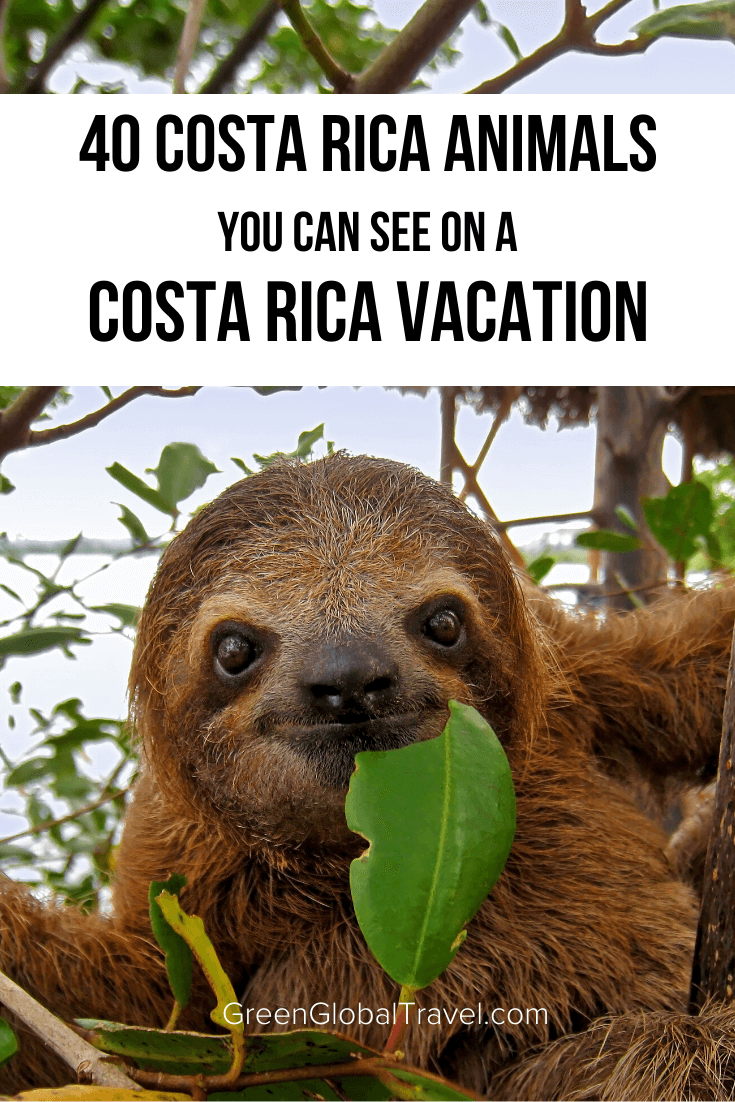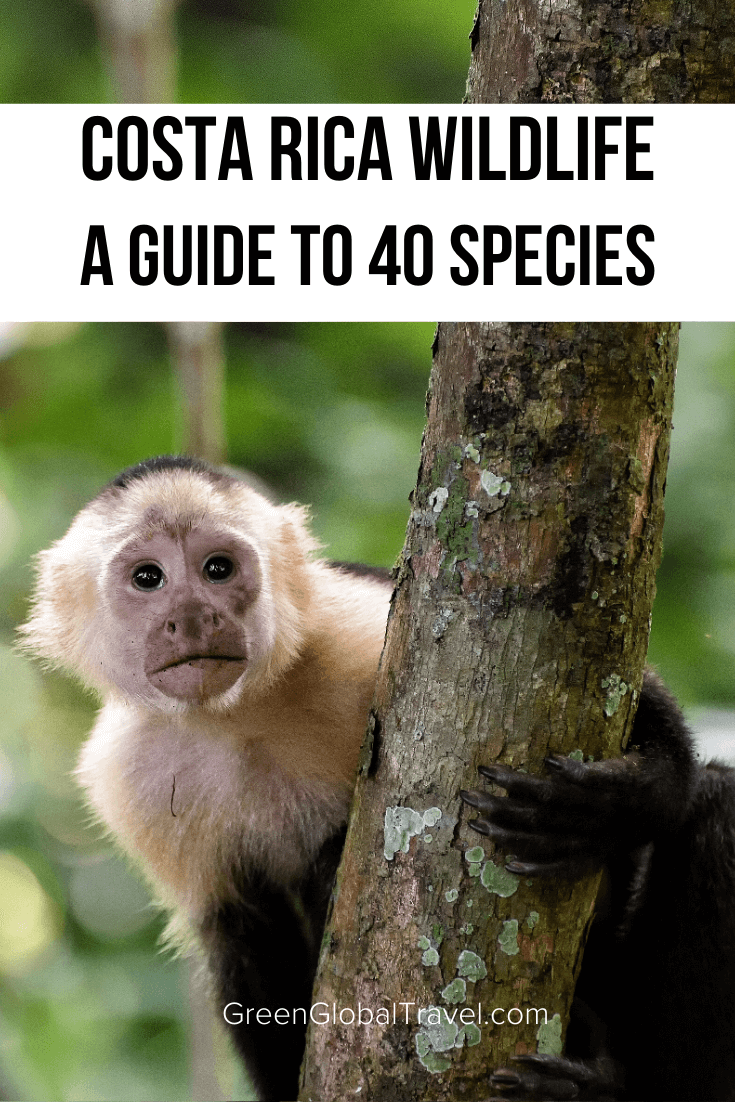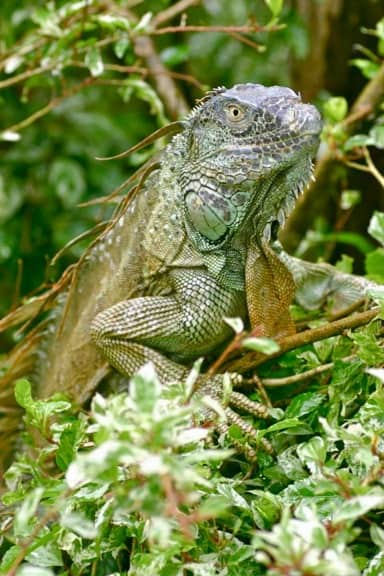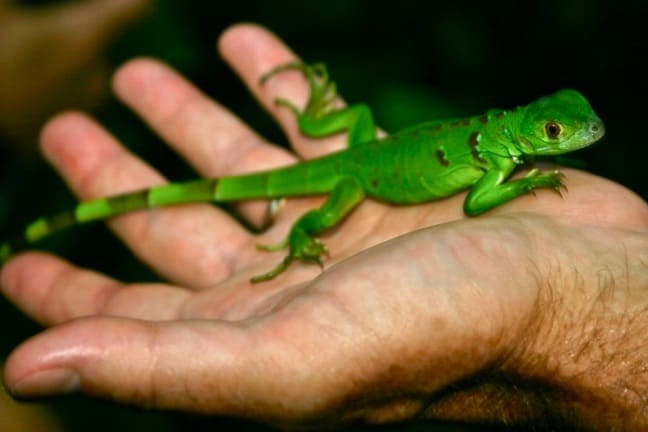[Updated 1/14/2020] The other day, during a conversation about the places we’ve traveled to and would never re-visit, we were flabbergasted when a friend suggested that a Costa Rica vacation had nothing further to offer her.
We’ve explored ecotourism in Costa Rica three times now. We’ve traveled its nooks and crannies, ranging from the rivers of Caño Negro Wildlife Refuge (near the Nicaragua border) to the remote Caribbean coast of Tortuguero National Park.
We’ve seen thousands of different Costa Rica animals, from massive mammals and reptiles to remarkably colorful Costa Rica birds, butterflies, and frogs.
With the country’s impressive array of ecosystems– from sunny beaches and volcano-fed hot springs to the world’s most bio-diverse rainforests– we honestly couldn’t imagine anyone getting bored traveling to Costa Rica.
Our appreciation was significantly heightened by our trip to the Osa Peninsula’s Corcovado National Park.
Called “the most biologically intense place on Earth” by National Geographic, the park contains approximately 5% of all wildlife species found on the planet.
Truth be told, Costa Rica wildlife is an animal-lover’s dream come true. To illustrate that point, we collaborated with our Green Travel Media pals to create this epic photo gallery of 40 Costa Rican wildlife species.
Though it contains only a fraction of the Costa Rica rainforest animals you might see during your visit (sadly, we got no shots of hard-to-spot species such as jaguars, anteaters, pumas, and harpy eagles), this Costa Rica wildlife guide should give you a taste of why we keep going back over and over again.
COSTA RICA ANIMALS GUIDE
- Costa Rica Birds
- Costa Rica Frogs
- Costa Rica Insects
- Costa Rica Mammals
- Costa Rica Reptiles
- Costa Rica Snakes
READ MORE: The 15 Best Places to Stay in Costa Rica
COSTA RICA BIRDS
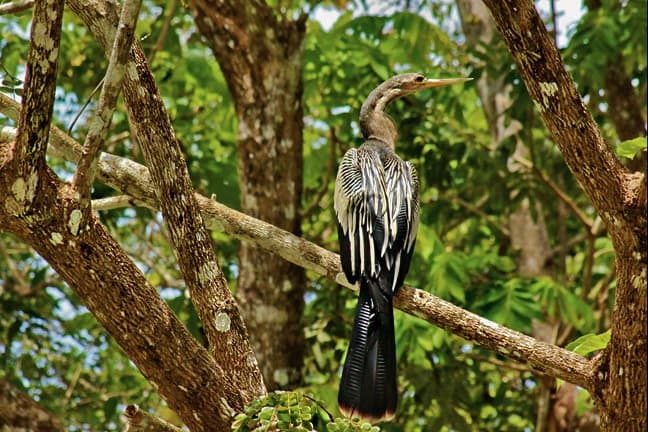
1. Anhinga (Snake Bird)
Latin Name: Anhinga anhinga
Habitat: Shallow water, marshes, swamps, mostly in freshwater
Size: 35 inches, 3.7-foot wingspan, 2-3 pounds
Diet: Fish, crustaceans, invertebrates
Conservation Status: Least Concern, population decreasing
Taking the shape of a cross when in flight, anhingas are long, slim birds that are native to shallow freshwater bodies.
Males are black and silver, while female and young anhingas are tan in color. The wingspan of anhingas stretches to about 43 inches.
These birds are known as snake birds due to their long necks, which protrude from the water in a serpentine style when they swim in search of food.
Though they somewhat resemble cormorants when they’re inactive, anhingas are set apart when they utilize their long necks and pointy bills to feed on fish.
READ MORE: Top 20 Things To Do In Costa Rica (for Nature & History Lovers)
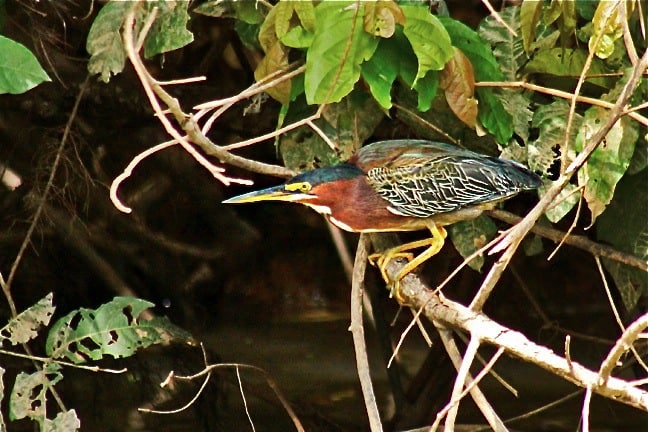
2. Black-Crowned Night Heron
Latin Name: Nycticorax ncyticorax
Habitat: Salt wetlands, freshwater marshes, swamps
Size: 23-28 inches, 45-inch wingspan, 1.5-2 pounds
Diet: Fish, squid, crustaceans, snakes, frogs, aquatic insects
Conservation Status: Least Concern, population decreasing
With short, squat bodies and a slow-moving disposition during the day, Black-Crowned Night Herons are known to come out at night.
Living in many different water-centric habitats, these birds can be found in swamps, rivers, and more. They’re often seen foraging in groups for fish and other aquatic animals.
The bird is light gray, brown, black, and white in color, and can often be found hiding in the trees during the day.
When they come out at night, the heron can be heard making a variety of unique sounds amongst its colony.
READ MORE: Ecotourism in Costa Rica: The Ultimate Eco Travel Guide
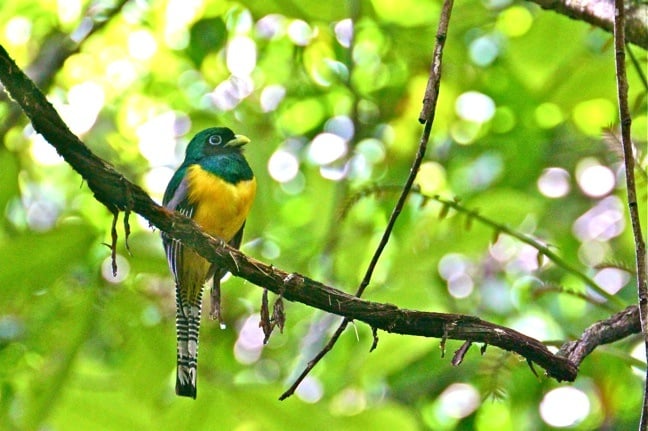
3. Black-Throated Trogon
Latin Name: Trogon rufus
Habitat: Tropical forest, low levels of forests/rainforests
Size: 9-10 inches, 54-57 grams
Diet: Arthropods, fruit
Conservation Status: Least Concern, population decreasing
A black throat stands out against the green or golden-colored body of the Black-Throated Trogon, which is found in lowland forest ecosystems throughout Central and South America.
These beautiful birds consume insects and fruit, and are relatively small (weighing 54-58 grams).
Despite their diminutive size, Black-Throated Trogons make deep sounds and whistles similar to other trogons.
These birds are frequently seen perching for lengthy periods of time when they’re not hunting for food.
Thankfully, unlike some other Costa Rican animals, this bird is quite widespread and has a large population distribution.
READ MORE: Hiking Corcovado National Park Costa Rica
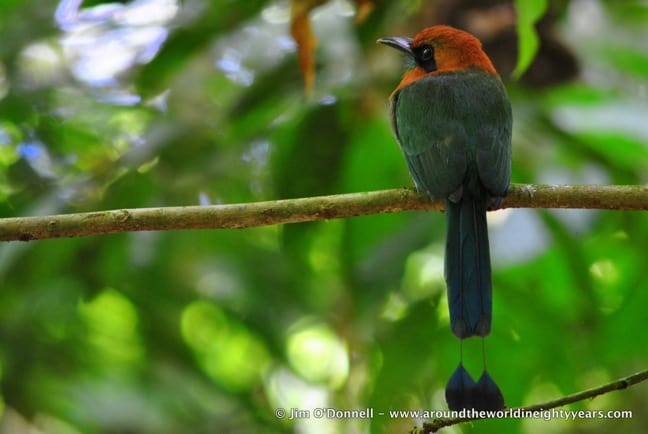
4. Broad-Billed Motmot
Latin Name: Electron platyrhynchum
Habitat: Tropical/Subtropic lowland forest
Size: 12-15 inches, 2.6 ounces
Diet: Insects, cicadas, frogs, lizards
Conservation Status: Least Concern, population decreasing
Native to forests with humid climates, Broad-billed Motmots are slightly smaller than Rufous Motmots, a similar-looking yet unrelated bird.
Despite their size, these birds also make harsh, deep noises. Broad-billed Motmots have bright coloring, with rufous-orange on the head and neck and blue and green on the back.
These birds are mostly found in South America and Costa Rican forests, feeding on insects and small reptiles.
They hunt their prey by waiting in the middle layers of the trees, and are very territorial.
READ MORE: Las Bolas, the Stone Spheres in Costa Rica at Finca 6
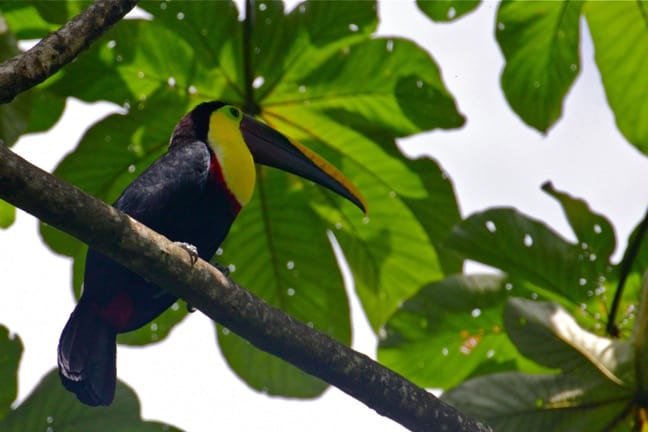
5. Toucans
Latin Name: Ramphastidae
Habitat: Tropical forests, savannas
Size: 11.5 inches, 1.5 pounds
Diet: Fruit mostly, frogs, insects, lizards
Conservation Status: Least Concern, population decreasing
The Toucan family includes around 40 different species, ranging from the 11.5-inch tall Lettered Aracari to the 29-inch Toco Toucan.
Sightings are fairly frequent, and they generally rank among the most popular birds of Costa Rica. Perhaps it’s because of their bright markings and huge colorful bills.
Or maybe it’s just the fact that it reminds people of a favorite childhood breakfast cereal.
The Chestnut-Mandibled Toucan, also known as Swanson’s Toucan, is a subspecies of the Yellow-throated Toucan, which is common from Honduras south to northern Colombia and western Ecuador.
These beautiful birds boast black bodies offset by vivid colors ranging from maroon (on their head, back, bill, and breast) and yellow (face, bill, breast) to green (eyes) and blue (legs).
Look for them in flocks of 3 to 12 members, feeding on fruit in the treetops.
READ MORE: Las Bolas, the Stone Spheres in Costa Rica at Finca 6
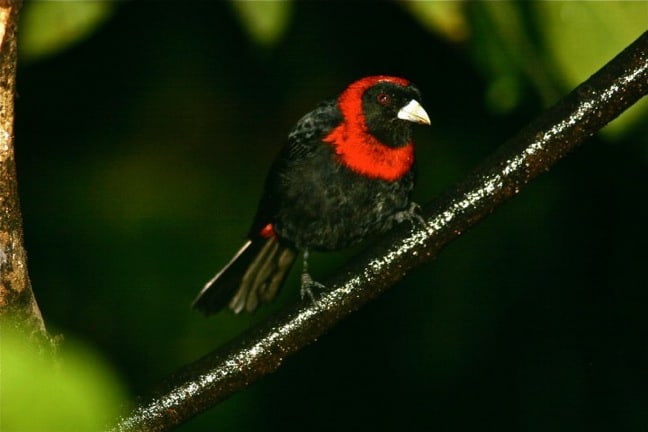
6. Crimson Collared Tanager
Latin Name: Ramphocelus sanguinolentus
Habitat: Tropical lowlands, Evergreen forests
Size: 7.5-8 inches, 35-48 grams
Diet: NO INFORMATION
Conservation Status: Least Concern, population stable
Standing out from the crowd with red and black feathers, the Crimson-collared Tanager is named for the bright red feathers around its neck and along its tail.
Referred to as a mystery bird by The Guardian, these birds do not have a “sister species.” Its DNA is not closely related to other birds, despite having basic physical similarities to some species.
They are sometimes confused with the similarly-named Crimson-collared Grosbeak, but ultimately stand alone.
The tanager lives in the humid forests of Central America, usually in the higher levels of foliage.
READ MORE: The Ultimate Tortuguero National Park, Costa Rica Travel Guide
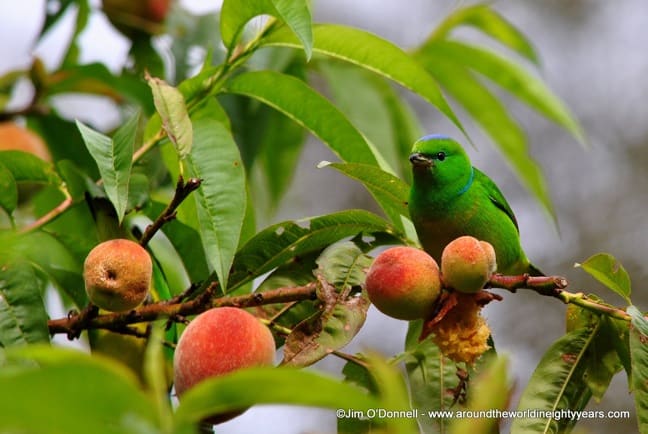
7. Golden-Browed Chlorophonia
Latin Name: Chlorophonia callophrys
Habitat: Forest canopy
Size: 5.1 inches, 24 grams
Conservation Status: Least Concern, population decreasing
These striking birds (which are also known as the Rualdo Bird) are bright blue, green, and yellow in color. But they’re not very commonly seen, as they live in the upper canopy of the forest.
There is an intriguing local legend surrounding the Golden-Browed Chlorophonia and its voice. It is believed that the bird befriended a young girl who lived near Costa Rica’s temperamental Poas Volcano.
When the girl was going to be sacrificed in order to save the village, the bird intervened by singing its beautiful song to the volcano and sparing the girl’s life.
This folk tale is considered a testament to the beloved bird’s inner and outer beauty.
READ MORE: 20 Biggest Forests in the World (For Your World Travel Bucket List)
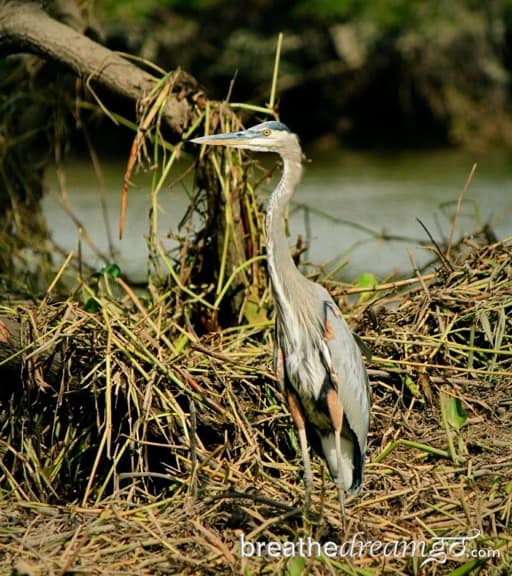
8. Great Blue Heron
Latin Name: Ardea herodias
Habitat: Fresh and saltwater lakes, swamps, shorelines
Size: 3.2-4.5 feet, 4.6-5.5 pounds
Diet: Fish, shrimp, crabs, aquatic insects
Conservation Status: Least Concern, population increasing
Blue-gray in color with a neck shaped like an “S,” the Great Blue Heron are birds with contradictory characteristics.
They can be found in both fresh and saltwater areas, and they hunt their food by standing perfectly still before impaling their prey.
Hunting is when they move the fastest, as these birds are usually slow-moving. They’re known to hunt during the day and night.
Another strange combination: Though they are the largest species of heron, the Great Blues only weigh about 5-6 pounds.
READ MORE: Protecting Whales & Dolphins in Golfo Dulce, Costa Rica
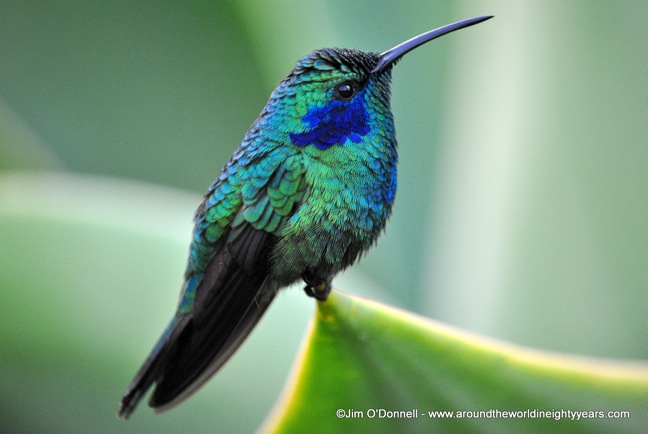
9. Green Violetear Hummingbird
Latin Name: Colibri thalassinus
Habitat: Middle and high elevation mountains
Size: 4.25-4.5 inches, .21 ounces
Diet: Nectar
Conservation Status: Least Concern
Also known as the Mexican Violetear, these colorful birds have violet feathers along the sides of the head, green and blue feathers along the front, and black coloring on its back.
Commonly found in the forests of Costa Rica, these birds are similar to the Wedge-Billed Hummingbird.
Like most hummingbirds, the Green Violetear feeds mostly on nectar as well as small insects.
Though small in size, these birds make a lot of noise. They emit various sounds and songs of 2 to 4 notes in length, along with a rapid wing clap that is used for attracting a mate.
READ MORE: How to Attract Hummingbirds To Your Garden
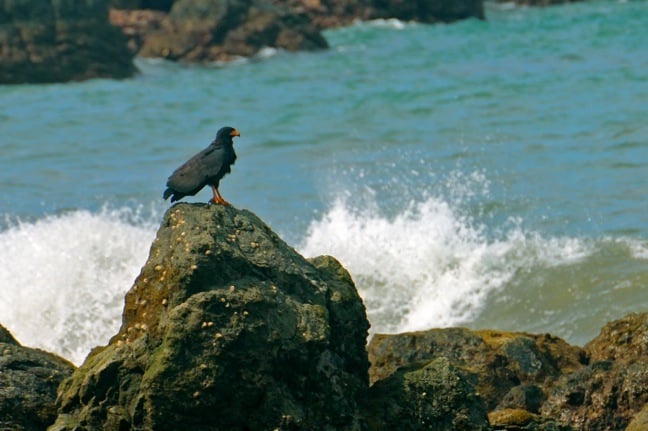
10. Mangrove Hawk
Latin Name: Buteogallus anthracinus subtilis
Habitat: Mangrove swamps
Size: 43-53 cm, 2-2.5 pounds
Diet: Crabs, small vertebrates, eggs
Conservation Status: No Recent Info
Found in coastal areas such as mangrove swamps, the Mangrove Hawk primarily feeds on crabs and fish.
These birds have large wings and can usually be found soaring in the air. They build their nests in mangrove trees, and lay one egg at a time.
Adults are black with a white section on their tail, while young Mangrove Hawks are more of a brown color.
This species is thought to be a subspecies of the common black hawk, which is found in Central and South America as well as the southwestern United States.
READ MORE: Best National Parks In USA For Wildlife Watching
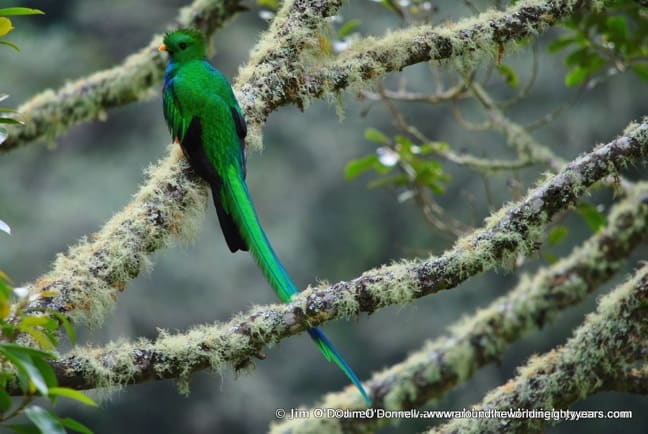
11. Resplendent Quetzal
Latin Name: Pharomachrus mocinno
Habitat: Tropical forests
Size: 15-16 inches, 7.1 ounces
Diet: Fruit, insects, ants, frogs, lizards
Conservation Status: Near Threatened, population decreasing
These tiny, brightly-colored birds are sure to grab people’s attention, easily ranking at the top of most Costa Rican birdwatchers’ bucket lists.
The Resplendent Quetzal’s bright green feathers have a dazzling sort of radiance to them, especially in contrast to the plain white and black feathers on its stomach.
Other species of Quetzal can’t quite compare.
These birds like to spend most of their time in tall cloud forests near the growth of fruit, which it eats along with insects. This tends to make spotting them all the more difficult, and special
Although these birds are small, they are quite powerful. About 20 percent of their body mass comes from their flight muscles, which makes foraging while they’re in flight an easy task.
READ MORE: Cano Island: Costa Rica Scuba Diving at its Finest
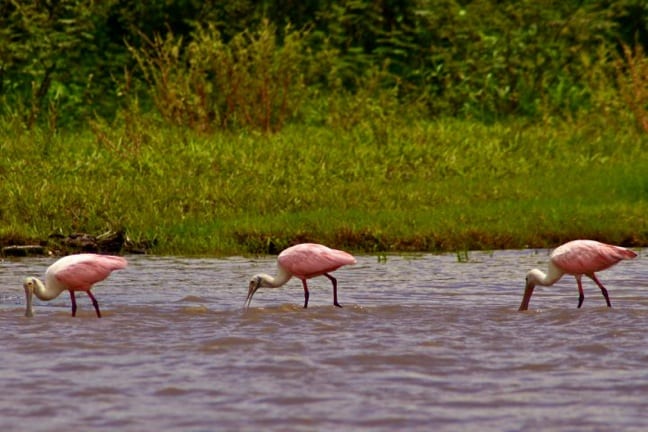
12. Roseate Spoonbill
Latin Name: Platalea ajaja
Habitat: Shallow freshwater, mangroves, swamps
Size: 71-86 cm, 2.3 pounds
Diet: Fish, shrimp, insects, mollusks
Conservation Status: Least Concern, population stable
The Roseate Spoonbill is part of the distinctive-looking spoonbill family, with five other subspecies being found outside the Americas.
This bird feeds in an unusual way, by swinging its spoon-shaped bill side to side in the water with its mouth open to find prey.
They reside in marshes and other wetlands, and can often be found feeding around mangrove estuaries.
In addition to its bizarre bill, the bird is named for its coloration. Much like flamingoes, their feathers are pink due to the consumption of fish and crabs that contain carotenoids, a natural pigment that’s also found in shrimp.
READ MORE: Can the Maritime Forest Survive Climate Change?
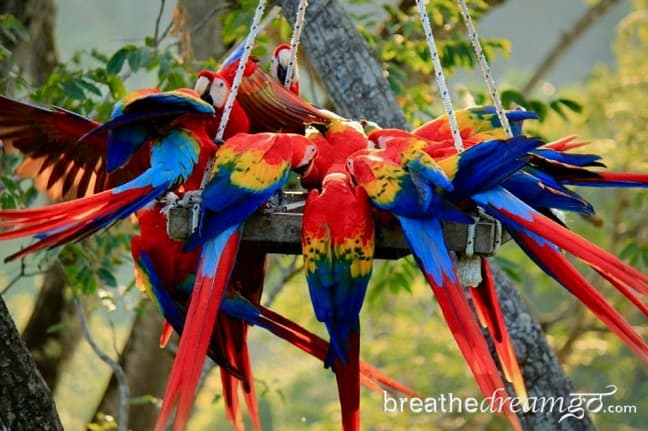
13. Scarlet Macaw
Latin Name: Ara macao
Habitat: Evergreen forests, tropical forests
Size: 2.9 feet, 2.3 pounds
Diet: Nuts, leaves, berries, seeds
Conservation Status: Least Concern, population decreasing
With bright colors all over its body, the Scarlet Macaw is the world’s largest parrot. Its gorgeous feathers are the three primary colors– blue, red, and yellow.
These massive birds, which are occasionally kept as pets, measure up to three feet in length and are very intelligent.
The bird lives in the humid evergreen forests of Central and South America, where it feeds on berries, nuts, and seeds found in their native habitat.
Unfortunately these birds are listed as threatened due to illegal trading and the destruction of their rainforest homes. But conservation efforts to stop these actions are helping to protect them.
READ MORE: The Problem with Animal Selfies
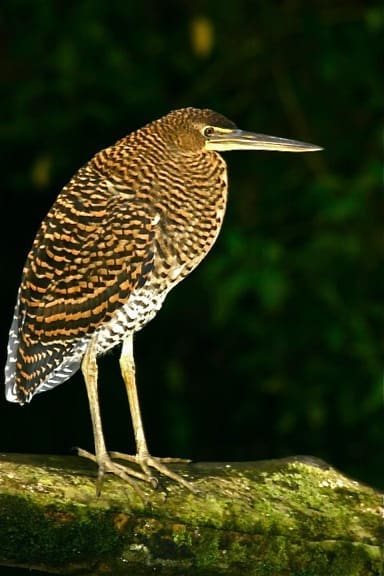
14. Tiger Heron
Latin Name: Tigrisoma lineatum
Habitat: Wetlands
Size: 26-30 inches, 1.3-2.2 pounds
Diet: Fish, crustaceans, water beetles
Conservation Status: Least Concern
Tiger Herons come in a few different shapes and colors. Bare-Throated Tiger Herons can be found throughout Costa Rica (usually near the water) and are the largest of all tiger herons.
These birds feed on a variety of prey, from fish to insects, and use their long, pointy bills to spear their food.
The body of this subspecies is black and gray, with green, yellow, and orange plumage.
Another subspecies, the Rufescent Tiger Heron, is named for its rufous coloring, and is smaller in size than the bare-throated variety.
READ MORE: Casa Corcovado Jungle Lodge: Eco Luxury in Costa Rica
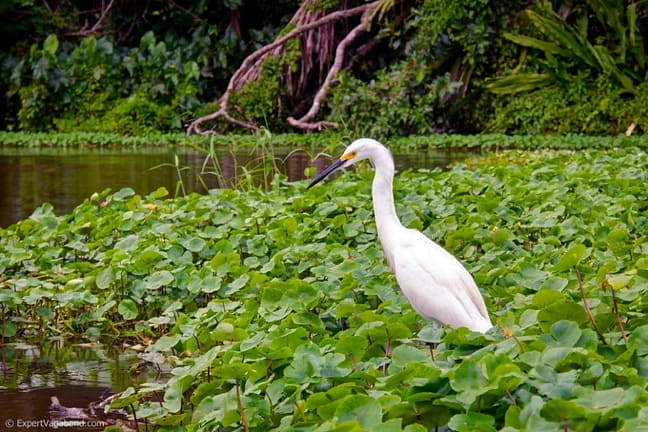
15. Snowy Egret
Latin Name: Egretta thula
Habitat: Salt and freshwater shallows, marshes, swamps, ponds
Size: 2 feet, 12 ounces
Diet: Fish, crustaceans, insects, grogs, crayfish
Conservation Status: Least Concern, population increasing
Named for its pure white body, the Snowy Egret’s white coloration is complemented by yellow feet and a black bill and legs.
Although their feet are usually greenish-yellow, these birds have been known to change color depending on the time of year.
During breeding season, their feet are more of an orange color and their feathers grow longer.
Found on the coast or in wetlands, these birds will often wait quietly in shallow water and use their bills to impale fish. But sometimes they put on a scene and run after prey through the water.
READ MORE: 10 Latin America Ecotourism Adventures (World Travel Bucket List)
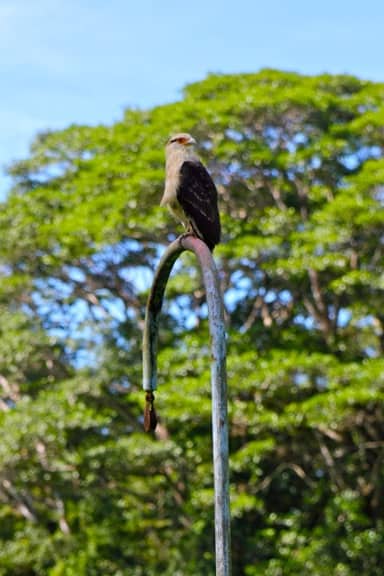
16. Yellow-Headed Caracara
Latin Name: Milvago chimachima
Habitat: Grassland, savanna, marshes
Size: 16-18 inches, 11.5 ounces
Diet: Carrion, dead animals
Conservation Status: Least Concern, population increasing
The Yellow-Headed Caracara is black and yellow in color with brown sections, and it will eat just about anything.
The bird has been known to feed on dead animals, insects, and other birds, either sitting high in the trees to catch living prey or walking along the road in search of roadkill.
This bird makes many sounds, ranging from a growl to a screech, and become aggressive toward others of its kind during mating season.
They may not have the best attitude, but they are very helpful to cattle when they perch on their backs, picking off the ticks.
READ MORE: Birds of the Galapagos Islands
Costa Rican Frogs & Toads
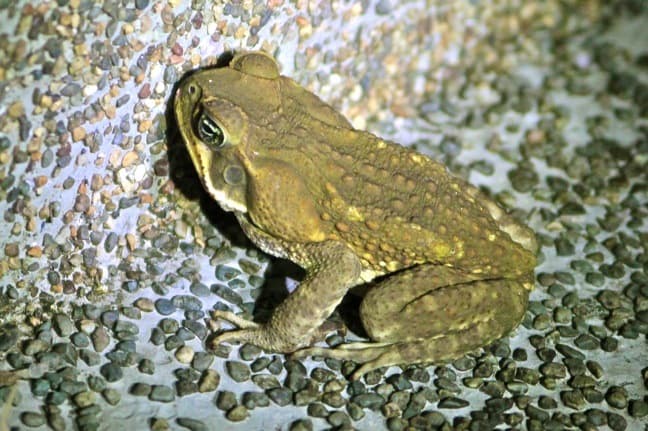
17. Evergreen Toad
Latin Name: Incilius coniferus
Habitat: Tropical rainforests, lowlands
Size: 2-3.7 inches
Diet: Small invertebrates
Conservation Status: Least Concern, population stable
Evergreen Toads can be found throughout various levels of Costa Rica’s humid forests, interacting with both the land and freshwater bodies.
This nocturnal toad behaves differently than many other amphibians by climbing trees. They have been reported to be found many meters above the ground.
However, a commonality with most other amphibians is that they typically breed near the water.
These toads are covered in various shades of green, ranging from yellow-green to dark green with black sections. They also feed on ants.
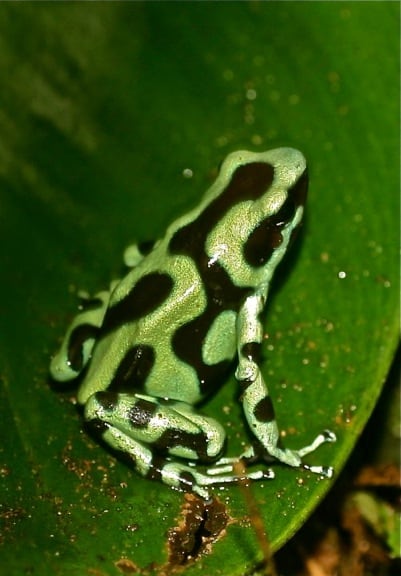
18. Green & Black Poison Dart Frog
Latin Name: Dendrobates auratus
Habitat: Rainforest floor
Size: .75 inches
Diet: Small invertebrates
Conservation Status: Least Concern
Although they are only 1.5 inches in length, these tiny amphibians pack one heck of a punch.
Green & Black Poison Dart Frogs are aptly named for their black and green coloring, as well as the poison in their skin.
These toxins (which indigenous natives once used to make deadly arrows) come from ants and other prey the frog consumes, and the poison is dangerous enough to kill a human!
Despite their ominous name, these frogs are necessary to their ecosystems. They help to keep the population of their prey— insects— under control by using their sticky toe pads and tongues.
READ MORE: Kurá Design Villas: Eco Luxury in Uvita, Costa Rica
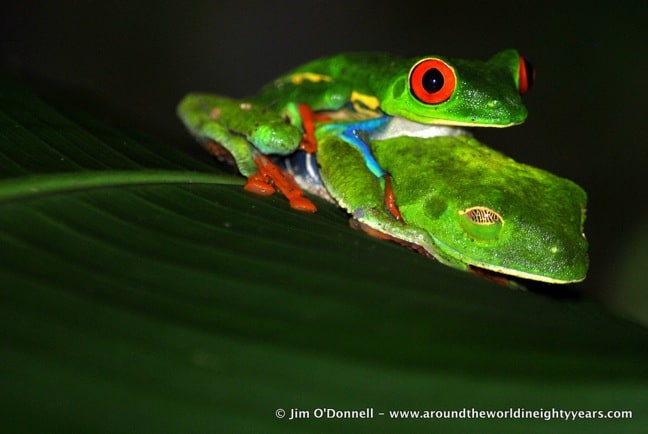
19. Red-Eyed Tree Frog
Latin Name: Agalychnis callidryas
Habitat: Tropical lowlands
Size: 2-3 inches, 15 grams
Diet: Insects, flies, grasshoppers
Conservation Status: Least Concern, population decreasing
Aptly named for its unnerving red eyes, these tree frogs likely developed their eye color genetically in order to scare away potential predators.
Their bright green bodies also scare away predators, since the color is too bright to process at night. The Christmas tree-like color combination definitely works in this frog’s favor.
These charming Costa Rican amphibians sleep underneath leaves during the day.
But they’ll immediately open their eyes wide when bothered, and there are a few toxins in its skin to keep potential predators at bay.
Bottom line: Don’t mess with the Red-Eyed Tree Frog!
READ MORE: Amazing Animal Facts: A-to-Z
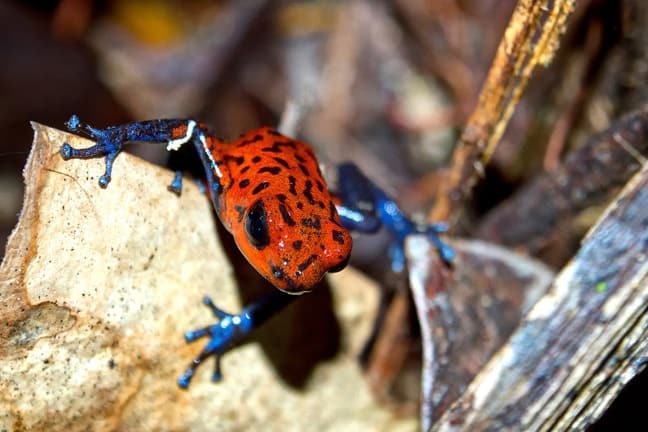
20. Strawberry Poison Dart Frog
Latin Name: Oophaga pumilio
Habitat: Rainforest floor
Size: .75-1.5 inches, 1 ounce
Diet: Insect eggs, ants, mites, flies, beetles
Conservation Status: Least Concern, population decreasing
Similar to the Green & Black Poison Dart Frog, the Strawberry Poison Dart Frog is about an inch long.
With a bright red or orange color to its body and blue legs, it’s also commonly referred to as the Blue-jeans Frog.
Living in rainforests, this awesome amphibian has toxins in its skin. They feed on small insects using their tongues.
Also like the Green & Black, the Strawberry Frog is necessary to its ecosystem by controlling the population of ants and other pests.
This vivid species is not currently listed as threatened. But people capturing them as pets is posing a growing risk to the population.
Insects of Costa Rica

21. Elephant Beetle
Latin Name: Megasoma elephas
Habitat: Tropical rainforests
Size: 2.75-4.75 inches (males 3 times bigger than females)
Diet: Sap, fruit
Conservation Status: Data Deficient
Known by many different nicknames (including the Rhinoceros, Hercules, and Atlas Beetle), the Elephant Beetle is a hard sight to overlook.
Male Elephant Beetles actually have split horns on their heads, along with a black or dark green body and a huge mass of around 35 grams.
One variation comes in their body hair, with some being smooth and others coated in fine hair.
The longest of these beetles can reach a length of seven inches, with more than half of that length being their horns.
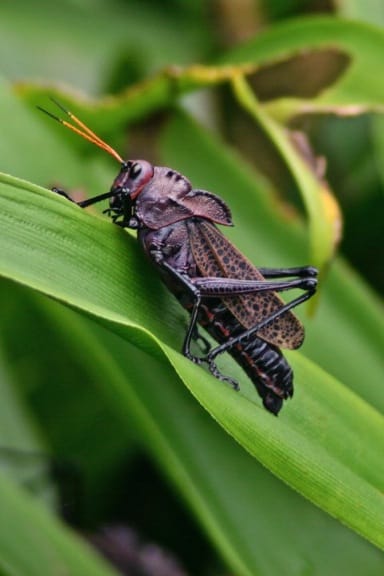
22. Giant Red-Winged Grasshopper
Latin Name: Arphia pseudonietana
Habitat: Rocky mountain pastures
Size: 4 inches
Diet: Flies
Conservation Status: Data Deficiente
Out of the 11,000 different species of grasshopper, the Giant Red-Winged Grasshopper is one of the biggest, with a total body length of about seven inches.
Another striking aspect of these bugs is their color change. Young Giant Red-Winged Grasshoppers start out resembling bees, with a black and yellow color scheme.
As adults, this color changes to orange and green. These creatures are also very protective of themselves, with an armor-like shell on their backs.
When necessary, they’ve been known to kick predators with their powerful back legs.
COSTA RICAN MAMMALS
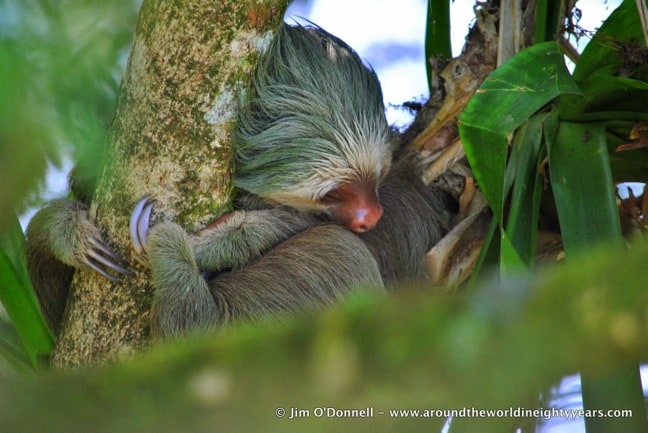
23. Brown-Throated Sloth
Latin Name: Bradypus variegatus
Habitat: Tropical forests
Size: 17-31 inches, 5-14 pounds
Diet: Leaves, twigs, fruit
Conservation Status: Least Concern
Moving very slowly and taking its time, Brown-throated Sloths are named for the light brown fur on their necks and their bodies.
Curved claws enable sloths to hang upside down on trees throughout the tropical environments they inhabit.
Sloths spend a majority of their time up in the trees, feeding on fruit as well as leaves and twigs from the trees.
Since they move so slowly, sloths can barely walk. This makes them among the favorite prey of predators such as jaguars.
But strangely, they are surprisingly decent swimmers.
READ MORE: 10 Eco Lessons in Quotes from the Lorax (Dr Suess’ Conservation Classic)
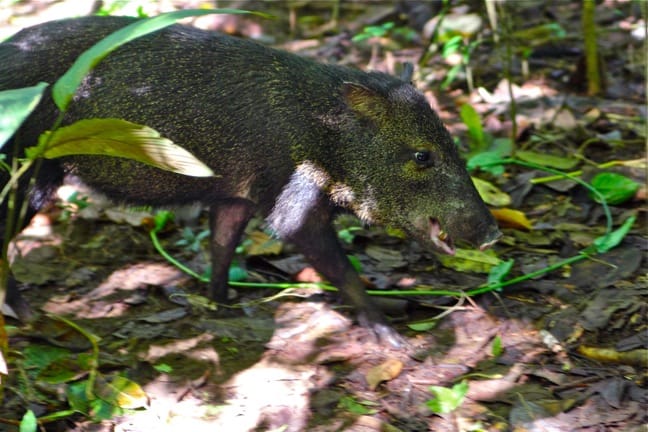
24. Collared Peccary
Latin Name: Pecari tajacu
Habitat: Tropical rainforests
Size: 2.9 feet, 45 pounds
Diet: Cactus, fruits, roots, palm nuts
Conservation Status: Least Concern, population stable
Resembling a hairy pig, collared peccaries have large snouts, sharp teeth, and bodies with small legs and tusks.
These territorial mammals move in herds when foraging for food such as berries, grass, and occasionally small reptiles.
Peccaries stay out of the sun in the summer and only come out at night, whereas they are often seen out and about during the day in winter.
If you happen upon them, be wary: They have poor eyesight, and will charge when they feel threatened.
Also known as the javelina, they are called collared peccaries due to the white fur on their necks, which looks like a collar against the dark fur on the rest of their bodies.
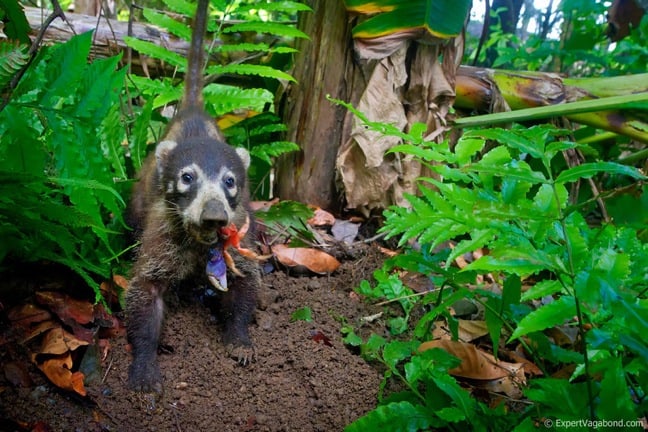
25. Coati
Latin Name: Nasua nasua
Habitat: Tropical rainforest, lowland tropical rainforests
Size: 1.5-1.9 feet, 8.2-8.8 pounds
Diet: Invertebrates, fruit, ground litter
Conservation Status: Least Concern, population decreasing
Related to raccoons and about the size of a cat, the omnivorous Coati (a.k.a. Coatimundi) sleeps in the trees and forages for insects, fruit, and small reptiles during the day.
Females and young Coatis usually travel together in bands, while males live a solitary life except during mating season.
These Costa Rica jungle animals are known to be skilled climbers, foraging in the trees for food.
Unfortunately, at popular Costa Rica tourist attractions such as Monteverde Cloud Forest Reserve, they’ve also turned into shameless beggars.
Their most distinctive feature may be their long tails, which are reddish in color (like the rest of its body) and encircled with dark stripes.
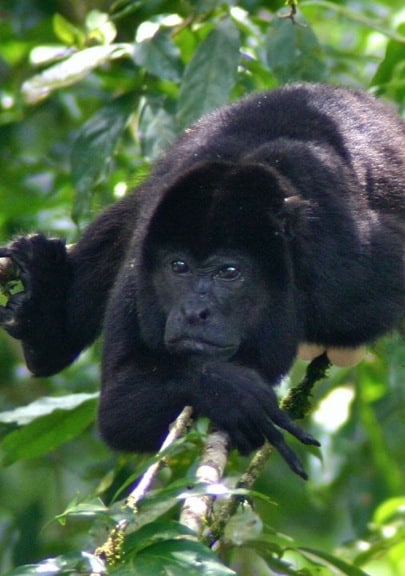
26. Howler Monkey
Latin Name: Aloutta
Habitat: Mountain rainforests (Most time spent in canopy)
Size: 1.8-3.6 feet, 8.8-22 pounds
Diet: Leaves, fruit, flowers, nuts, plants
Conservation Status: Least Concern – Data Deficient
With a loud cry and a heavy build, Howler Monkeys are hard to ignore. These monkeys have defined jaws and long, thick hair ranging in color from red to black.
Because their thyroid bones extend into their throats, howler monkeys are capable of making extremely loud, resonant sounds.
In the wilds of Costa Rica, their booming voices can be heard all day, every day, rain or shine, up to a distance of 3 miles! (They were our daily wake up call at Casa Corcovado Jungle Lodge.)
Howlers live in groups led by an elder male, residing in the trees and moving very slowly otherwise.
READ MORE: What Is An Eco Lodge? A Guide to “Green” Accommodations
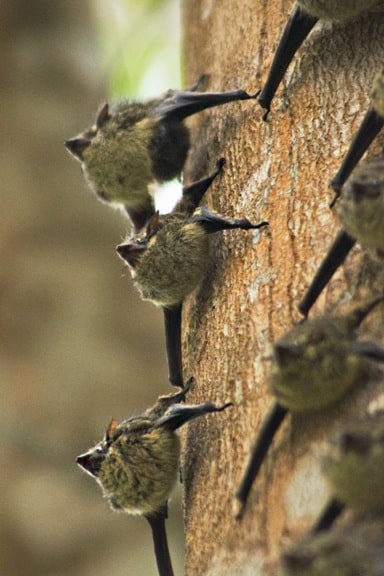
27. Long-Nosed Bat
Latin Name: Leptonycteris yerbabuenae
Habitat: Lowlands
Size: 2.5-3 inches, .6-1 gram
Diet: Nectar
Conservation Status: Vulnerable, population decreasing
The Lesser Long-Nosed Bat (a.k.a. the Mexican Long-Nosed Bat) is larger than most other bats, with a length of up to 3.75 inches.
The Long-Nosed Bat feeds on nectar at night, hovering like hummingbirds over plants.
Unfortunately these bats are declining in population, and it is thought that their diet has something to do with it.
Due to a reduction in plants like the agave, these bats cannot consume all the nectar they need. More research is being done to see what else is causing issues for these creatures.
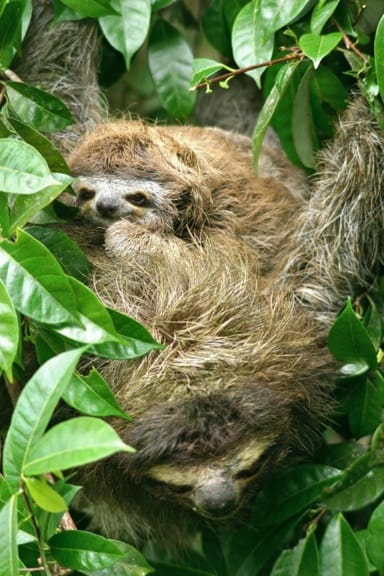
28. 3-Toed Sloth
Latin Name: Bradypus
Habitat: Tropical forests
Size: 18 inches, 8-10 pounds
Diet: Fruit, leaves, insects
Conservation Status: Endangered
Like the Brown-Throated Sloth, the 3-Toed Sloth is also incredibly slow, but has three toes as opposed to two. They are one of several endangered animals in Costa Rica.
They sleep for 15-20 hours a day and spend almost all of their time up in the trees, eating fruit and leaves at night and consuming water from plants as well.
3-Toed Sloths only leave the trees about once a week in order to relieve themselves. Since they are so slow, they have to watch out for potential predators in the process.

29. Spider Monkey
Latin Name: Ateles
Habitat: Tropical forests
Size: 2.6 feet, 2.9 pounds
Diet: Fruit, seeds, flowers, roots
Conservation Status: Data Deficient
They may not have eight legs, but Spider Monkeys do have long arms and a long tail that help them swing from tree to tree throughout their rainforest habitats.
These loud monkeys communicate with several different sounds, including screeches and barks. They can often be found foraging for foods such as fruit, nuts, and their namesake—spiders—while up in the trees.
Interestingly, these monkeys have a surprisingly strong grip on branches despite not having thumbs. Their prehensile tails more than make up for the absent finger.
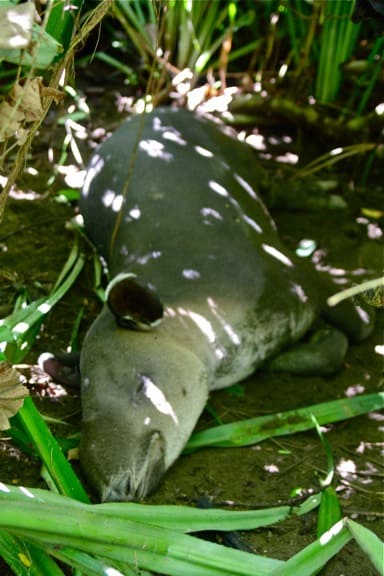
30. Tapir
Latin Name: Tapirus
Habitat: Grasslands, tropical rainforests
Size: 6.6 feet, 330 pounds
Diet: Fruit, berries, leaves
Conservation Status: Vulnerable, population decreasing
Although they look like pigs, the Tapir is related to both rhinoceroses and horses and have a trunk like elephants.
This bizarre creature (one of our favorite Costa Rican animals) uses its trunk to grab food. They have existed on earth for millions of years relatively unchanged, which only adds to their unusual mystique.
Another elephant-like characteristic of Tapirs is their dispersal of seeds throughout their habitats by defecating, which make them a vital part of their ecosystems.
There are five different species of Tapir. One thing they all have in common is the coloring of young Tapirs, a light-brownish shade that helps them stay camouflaged.
READ MORE: 60 Weird Animals Around The World

31. White-Faced Capuchin
Latin Name: Cebus imitator
Habitat: Forests
Size: 13-18 inches, 6.4-8.6 pounds
Diet: Fruits, berries, insects, plants
Conservation Status: Least Concern
Unlike other capuchins, the White-Faced Capuchin monkey has a white chest and forearm area and a tan face surrounded by white fur, which stands in stark contrast to its black body.
These animals that live in Costa Rica, can also live in many different climates, but usually go for a tropical or dry forest habitat.
These monkeys are incredibly social, taking many mating partners. They use a variety of activities to bond with one another, such as putting their fingers in another monkey’s nose.
READ MORE: My Stupid Mistake Hiking Corcovado National Park (Costa Rica)
COSTA RICA REPTILES
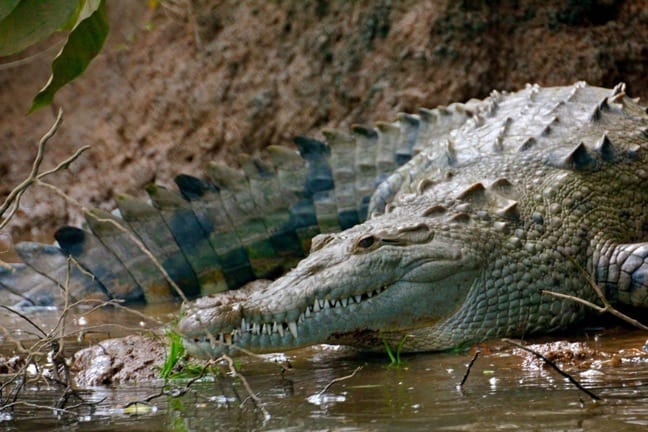
32. American Crocodile
Latin Name: Crocodylus acutus
Habitat: Saltwater ponds, coves, creeks, mangrove swamps
Size: 9.8-16 feet, 380-1,100 pounds
Diet: Fish, crabs, turtles, snakes, small mammals
Conservation Status: Vulnerable, population increasing
Found throughout the Caribbean as well as the south Florida, American crocodiles are one of 23 crocodilian species.
These reptiles are distinct from other crocodiles due to their isolated nature, spending much of their time basking or swimming in saltwater habitats.
American crocodiles eat a variety of prey, including fish, small mammals, and other reptiles, yet are usually not aggressive toward humans.
These massive reptiles can weigh up to a ton and live as long as humans (around 70 years).
Due to conservation efforts, the American crocodile is no longer endangered, meaning these creatures may be able to live even longer.
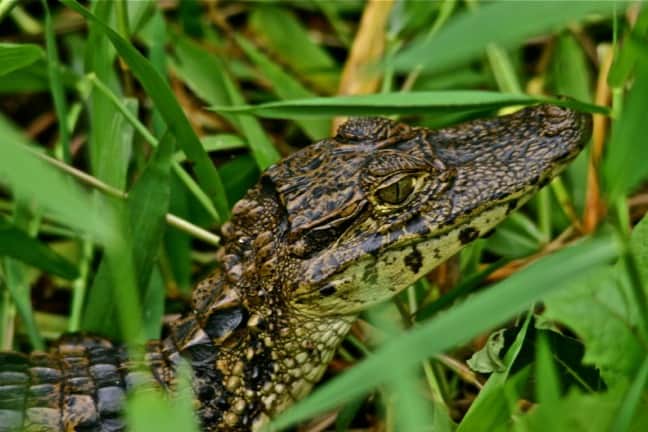
33. Caiman
Latin Name: Caimaninae
Habitat: Rivers, marshes, swamps, lakes, mangroves
Size: 13 feet, 13-88 pounds
Diet: Amphibians, fishes, aquatic insects, crustaceans
Conservation Status: Data Deficient
There are three species of caiman, a reptile native to Central and South America.
These crocodilians live in both freshwater and saltwater habitats and are a dark green color.
The dark coloring works to their advantage since they hunt for food at night, feeding on various creatures, ranging in size from insects to turtles.
Caimans have even been known for cannibalism in desperate periods, but are usually not so aggressive. They live on average 30-40 years and are solitary except during mating periods.
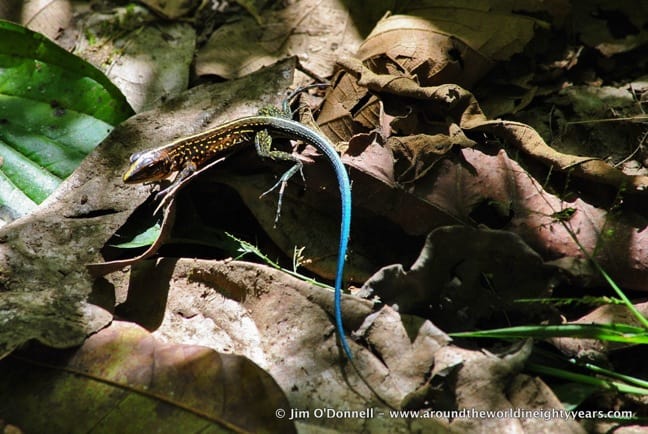
34. Central American Whiptail
Latin Name: Ameiva festiva
Habitat: Open habitats
Size: 10-14 inches
Diet: Grasshoppers, beetles, ants, spiders
Conservation Status: Data Deficient
A light strip along its spine and light spots on its body distinguish the Central American Whiptail from similar species.
Found in humid Central American forests, these lizards hunt for insects and small lizards during the day by digging into fallen leaves. They prefer to be out and about on hot days.
Young Central American Whiptails can be easily identified through their blue tails, which darken to brown with age.
All of these lizards have light-colored spots on their backs, which stand out against their dark color.
35. Green Iguana
Latin Name: Iguana iguana
Habitat: Rainforest canopy
Size: 6-7 feet, 20 pounds
Diet: Flowers, fruit, plants
Conservation Status: No Recent Data
Longer than the average human is tall, Green Iguanas can reach up to seven feet in length and weigh up to 20 pounds.
Adding to their distinctive dragon-like appearance is the presence of spikes along the backs of adult male Iguanas.
These reptiles are avid climbers, often climbing up to 50 feet in the trees. But they can also be found swimming on occasion.
Although they are called Green Iguanas, they can also be found in several other colors, including orange, blue, and black. They use their strong vision to see ultraviolet light.
READ MORE: Green Iguana Conservation Project [VIDEO]

36. Jesus Christ Lizard
Latin Name: Basiliscus basiliscus
Habitat: Tropical rainforests
Size: 2-2.5 feet, 4.8-6.8 ounces
Diet: Plants, fruit, insects
Conservation Status: Vulnerable
Also known as the Green Basilisk Lizard, the Jesus Christ Lizard is named after one of the most famous men in the world due to their shared ability to walk (or run, in the lizard’s case) on water.
Although they spend most of their time in the trees, these lizards can run across the water in emergencies at a lightning-fast speed of five feet per second.
Since they move so quickly, the extra skin on their feet creates an air pocket upon which they can run across the water for up to 15 feet at a time.
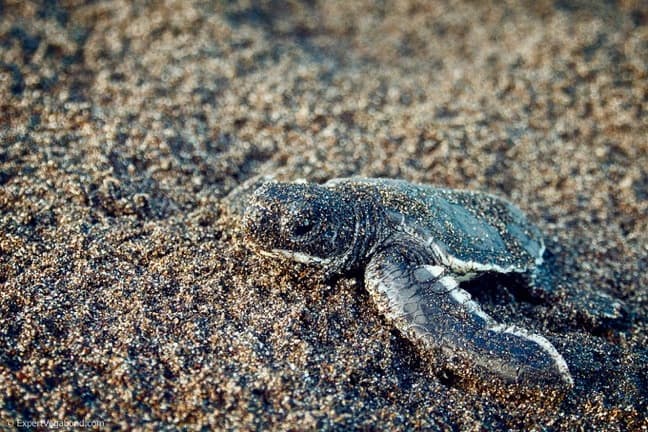
37. Sea Turtle
Latin Name: Chelonioidea
Habitat: Tropical/Subtropical beaches
Size: 83-114 cm, 350 pounds
Diet: Crustaceans, fish
Conservation Status: Endangered
One of the oldest creatures on earth (dating back to around 110 million years ago), Sea Turtles are basically like living fossils.
These precious reptiles can be found in warm-water climates all around the world.
If you’re extremely lucky you may find them at night on the beach, where they lay eggs. If you do, do not disturb them or shine lights in their direction.
Despite their rich history, sea turtles are increasingly vulnerable due to human activities such as pollution and destruction of their marine habitats and are.
Sea turtles do a lot for their marine environment. In order to keep them around, illegal poaching (which is a serious issue in Costa Rica) and climate change need to be addressed.
READ MORE: 30 Amazing Galapagos Island Animals
COSTA RICA SNAKES
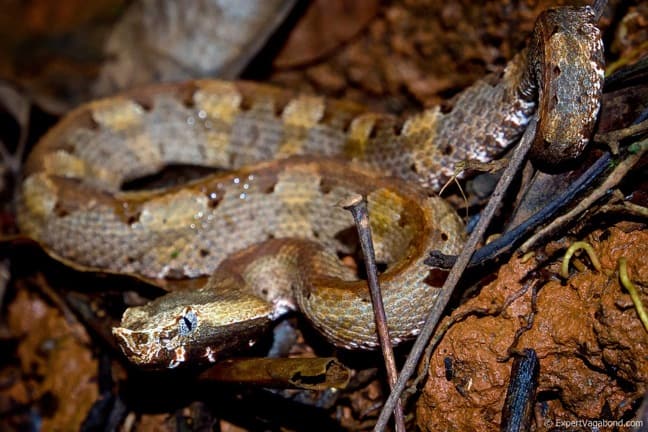
38. Hognosed Pit Viper
Latin Name: Portghidium nasutum
Habitat: Rainforests, lowlands
Size: Up to 14 inches
Conservation Status: Least Concern, population stable
Hognosed Pit Vipers are animals native to Costa Rica and live in lower levels of the rainforest. This snake has an unusual feature– its snout-like nose.
Ranging in length from 16 to 24 inches, the females of this species are known to be bigger than males, adding to their distinct appearance compared to other snakes.
Adult snakes feed on mammals, whereas the young ones will eat other reptiles as well.
Hog-nosed Pit Vipers have been observed blending in well with their surroundings and laying perfectly still, keeping to themselves when humans are around.
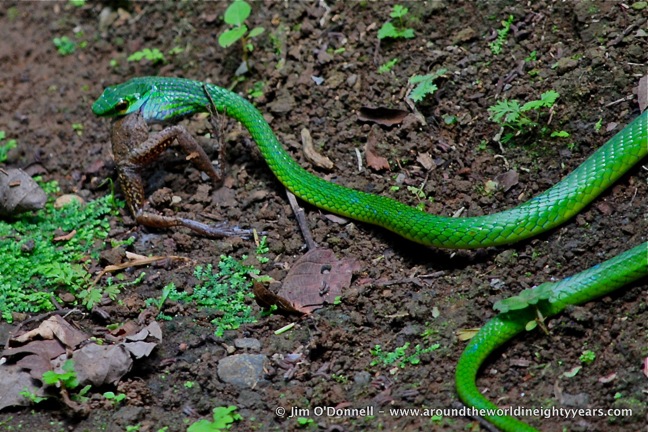
39. Parrot Snake
Latin Name: Leptophis ahaetulla
Habitat: Evergreen forests
Size: 68 inches
Diet: Frogs, lizards, small birds, eggs
Conservation Status: Vulnerable
The Parrot Snake can be commonly found in the rainforests of Costa Rica as well as more than a dozen other countries in Central and South America.
These snakes are multicolored, with green, black, and gold/bronze areas on their bodies. They can grow to be nearly 70 inches long, including a 2-foot-long tail.
The Parrot Snake is mostly harmless since it is only mildly venomous. The worst effects of venom are swelling and centralized pain, which usually goes away after a few hours.
This snake eats smaller reptiles (such as lizards), frogs, and small birds.
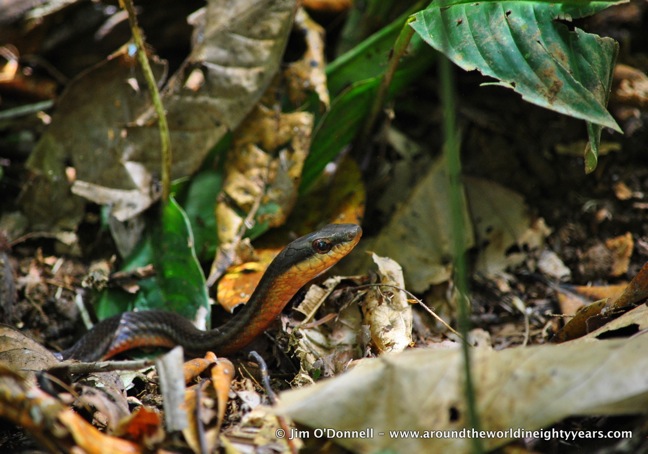
40. Salmon-Bellied Racer
Latin Name: Mastigodryas melanolomus
Habitat: Evergreen Forests
Size: Up to 4 feet
Diet: Mainly lizards
Conservation Status: Data Deficient
The Salmon-Bellied Racer can most often be found in the lower levels of the rainforest. But it can handle a variety of different habitats, which has helped its population to thrive.
This snake is named for its salmon-colored stomach, which develops as an adult and stands out against the rest of its dark brown body. Young snakes have brown coloring until they reach maturity.
These snakes are also identifiable for their impressive speed and their large eyes, which they use to seek out their lizard prey. –by Anika Chaturvedi & Bret Love
Looking to book a room in Costa Rica? Check out these great options!
Parque Del Lago Boutique Hotel – Where we stayed in San Jose
Tabacon Thermal Resort & Spa – Where we stayed in Fortuna
La Quinta Sarapiqui Lodge – Where we stayed in Sarapiquí
Kura Design Villas – Where we stayed in Uvita
Mawamba Lodge – Where we stayed in Tortuguero
Casa Corcovado Jungle Lodge -Where we stayed on the Osa Peninsula
Looking for essential Costa Rica Travel Gear? Check out these great options!
The Best Travel Clothes for Women & Men
The Best Hiking Boots & Hiking Shoes
Cool Camping Gear
The Best Backpacks for Travelers
Looking to book your next trip? Check out the following services we use!
TrustedHousesitters – we’ve found great pet sitters to watch our house and love on our two dogs.
Matthew Karsten’s photos provided via Expert Vagabond
Jim O’Donnell’s photos provided via Around the World in Eighty Years
Mariellen Ward’s photos provided via Breathedreamgo
Barbara Weibel’s photos provided via Hole In The Donut Cultural Travel

